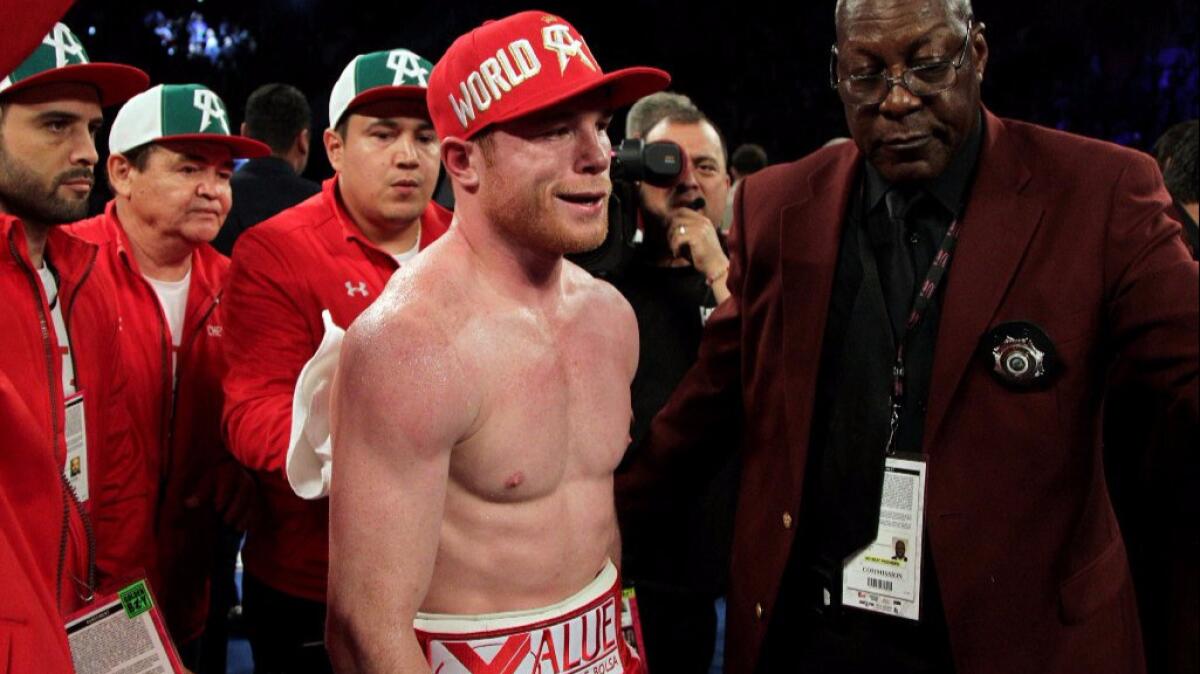Column: With the appeal of pay-per-view fights disappearing, boxing really is on the ropes

- Share via
This column will start with a consumer-friendly warning: I’m writing about boxing.
So if you want to direct your attention to our Dodgers or Rams coverage, go ahead. You probably should.
Because boxing is dead.
Now, you have probably read something like this every few years and you know that predictions of the sport’s demise have always been wrong. Boxing continued to survive, if not thrive, with new benchmarks in pay-per-view viewership established in every passing decade.
Except today, the sport looks as if it is really in trouble.
While boxing has already existed outside of the mainstream over the last couple of decades, it managed to reclaim center stage by producing an occasional megafight. Now, even that is under threat, with the sport looking destined to remain solely on the fringes of the American sports landscape.
This isn’t about short-sighted promoters, corrupt sanctioning bodies, the emergence of mixed martial arts or any of the other impediments that have gradually moved the sport out of the public consciousness.
This is about something far more fundamental.
This is about a shortage of talent.
Really, how many boxers today could convince the average sports fan to pay upwards of $60 for a pay-per-view telecast?
About the only marketable fighter remaining in the sport is Mexican junior-middleweight Canelo Alvarez, who owes his popularity more to his looks than his ability in the ring. And even he would almost certainly have to move up in weight to take on middleweight champion Gennady Golovkin to produce a million-buy fight.
Fighting Liam Smith of England, which is what Alvarez will do Saturday, won’t do it.
The modern fighter who believes he is on the brink of crossing over doesn’t have the luxury of remaining at his weight class, as there is a glaring lack of depth in every division. Alvarez’s situation demonstrates the dilemma: Remain at optimal weight and take on anonymous opposition in front of modest audiences or move up and risk life-threatening injuries.
This wasn’t always the case. When Alvarez’s promoter, Oscar De La Hoya, was an active fighter, there were multiple big-dollar options in every division. Take a look at the fighters who were in the welterweight division when De La Hoya was there in the late 1990s — Felix Trinidad, Ike Quartey, Shane Mosley, Pernell Whitaker. De La Hoya didn’t have to move up to 154 pounds until his body was ready.
That changed over the last 15 years.
The pay-per-view stars of the last generation, Floyd Mayweather Jr. and Manny Pacquiao, obscured the lack of depth in the sport by scaling up multiple weight classes and taking the most marketable fighters at every stop.
But Alvarez doesn’t have the talent of Mayweather or Pacquiao. The only fighter who does is 115-pound champion Roman Gonzalez, whose mainstream appeal is limited by his small stature.
While Alvarez is one of the sport’s best combination punchers, his feet are painfully slow. So he gets hit. For him, fighting in a heavier division would be dangerous — and in boxing, unlike in most other sports, dangerous literally means dangerous. It’s hard to blame him for his reluctance to move up until the 34-year-old Golovkin has been further diminished by time.
Equally problematic is what this dynamic means for up-and-coming fighters. If a Pacquiao were to emerge today, could he still become Pacquiao?
The start of Pacquiao’s ascension coincided with there being a group of talented Mexican fighters at his weight class that included Marco Antonio Barrera, Erik Morales and Juan Manuel Marquez. His fights against them established his credibility as a fighter and served as a foundation for his impending crossover stardom.
Compare that to what is happening with Terence Crawford, a champion at 140 pounds. Crawford, 28, looks like he might be a star. But the truth is we have no idea how good he is. He has been a champion for more than two years and he still hasn’t taken on a noteworthy opponent.
The majority of you reading this have probably never heard of him. And odds are, you never will.
Twitter: @dylanohernandez
ALSO
Promoter: Oct. 15 is out as a date for a Southland multi-title boxing card
Daniel Jacobs embraces his position as Gennady Golovkin’s mandatory foe
Boxing’s Lou DiBella recalls moving meeting with Bobby Chacon
More to Read
Go beyond the scoreboard
Get the latest on L.A.'s teams in the daily Sports Report newsletter.
You may occasionally receive promotional content from the Los Angeles Times.










